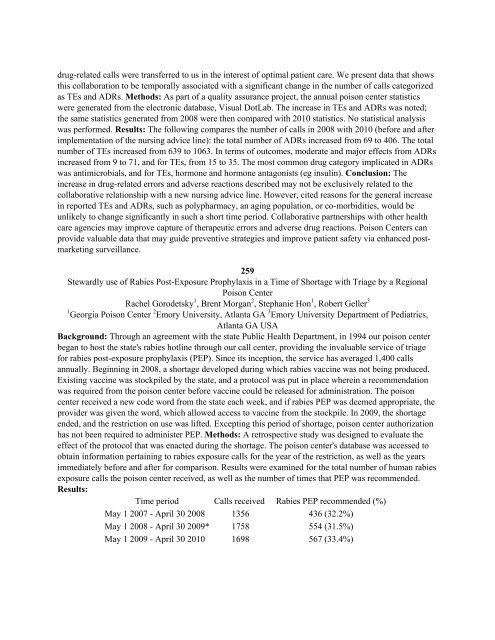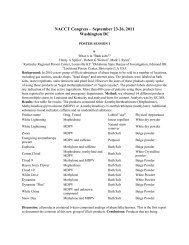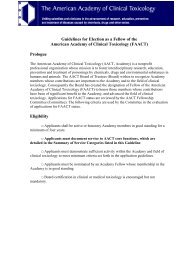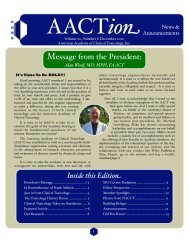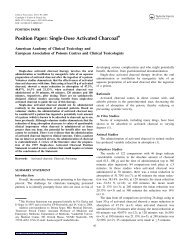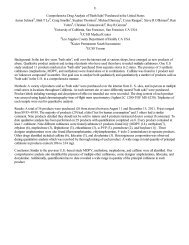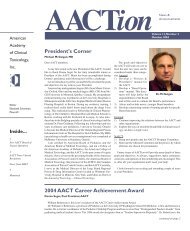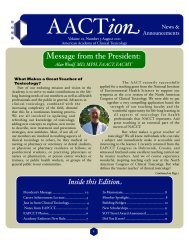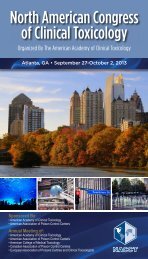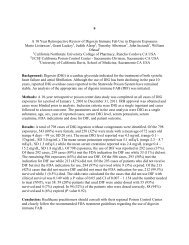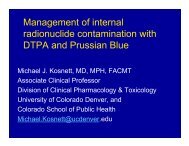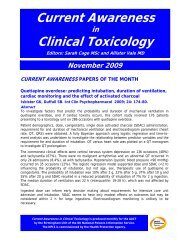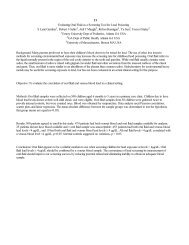Posters IV - The American Academy of Clinical Toxicology
Posters IV - The American Academy of Clinical Toxicology
Posters IV - The American Academy of Clinical Toxicology
You also want an ePaper? Increase the reach of your titles
YUMPU automatically turns print PDFs into web optimized ePapers that Google loves.
drug-related calls were transferred to us in the interest <strong>of</strong> optimal patient care. We present data that shows<br />
this collaboration to be temporally associated with a significant change in the number <strong>of</strong> calls categorized<br />
as TEs and ADRs. Methods: As part <strong>of</strong> a quality assurance project, the annual poison center statistics<br />
were generated from the electronic database, Visual DotLab. <strong>The</strong> increase in TEs and ADRs was noted;<br />
the same statistics generated from 2008 were then compared with 2010 statistics. No statistical analysis<br />
was performed. Results: <strong>The</strong> following compares the number <strong>of</strong> calls in 2008 with 2010 (before and after<br />
implementation <strong>of</strong> the nursing advice line): the total number <strong>of</strong> ADRs increased from 69 to 406. <strong>The</strong> total<br />
number <strong>of</strong> TEs increased from 639 to 1063. In terms <strong>of</strong> outcomes, moderate and major effects from ADRs<br />
increased from 9 to 71, and for TEs, from 15 to 35. <strong>The</strong> most common drug category implicated in ADRs<br />
was antimicrobials, and for TEs, hormone and hormone antagonists (eg insulin). Conclusion: <strong>The</strong><br />
increase in drug-related errors and adverse reactions described may not be exclusively related to the<br />
collaborative relationship with a new nursing advice line. However, cited reasons for the general increase<br />
in reported TEs and ADRs, such as polypharmacy, an aging population, or co-morbidities, would be<br />
unlikely to change significantly in such a short time period. Collaborative partnerships with other health<br />
care agencies may improve capture <strong>of</strong> therapeutic errors and adverse drug reactions. Poison Centers can<br />
provide valuable data that may guide preventive strategies and improve patient safety via enhanced postmarketing<br />
surveillance.<br />
259<br />
Stewardly use <strong>of</strong> Rabies Post-Exposure Prophylaxis in a Time <strong>of</strong> Shortage with Triage by a Regional<br />
Poison Center<br />
Rachel Gorodetsky 1 , Brent Morgan 2 , Stephanie Hon 1 , Robert Geller 3<br />
1 Georgia Poison Center 2 Emory University, Atlanta GA 3 Emory University Department <strong>of</strong> Pediatrics,<br />
Atlanta GA USA<br />
Background: Through an agreement with the state Public Health Department, in 1994 our poison center<br />
began to host the state's rabies hotline through our call center, providing the invaluable service <strong>of</strong> triage<br />
for rabies post-exposure prophylaxis (PEP). Since its inception, the service has averaged 1,400 calls<br />
annually. Beginning in 2008, a shortage developed during which rabies vaccine was not being produced.<br />
Existing vaccine was stockpiled by the state, and a protocol was put in place wherein a recommendation<br />
was required from the poison center before vaccine could be released for administration. <strong>The</strong> poison<br />
center received a new code word from the state each week, and if rabies PEP was deemed appropriate, the<br />
provider was given the word, which allowed access to vaccine from the stockpile. In 2009, the shortage<br />
ended, and the restriction on use was lifted. Excepting this period <strong>of</strong> shortage, poison center authorization<br />
has not been required to administer PEP. Methods: A retrospective study was designed to evaluate the<br />
effect <strong>of</strong> the protocol that was enacted during the shortage. <strong>The</strong> poison center's database was accessed to<br />
obtain information pertaining to rabies exposure calls for the year <strong>of</strong> the restriction, as well as the years<br />
immediately before and after for comparison. Results were examined for the total number <strong>of</strong> human rabies<br />
exposure calls the poison center received, as well as the number <strong>of</strong> times that PEP was recommended.<br />
Results:<br />
Time period Calls received Rabies PEP recommended (%)<br />
May 1 2007 - April 30 2008 1356 436 (32.2%)<br />
May 1 2008 - April 30 2009* 1758 554 (31.5%)<br />
May 1 2009 - April 30 2010 1698 567 (33.4%)


